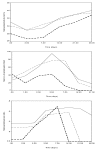Plasmodium falciparum gametocyte sex ratios in children with acute, symptomatic, uncomplicated infections treated with amodiaquine
- PMID: 18761752
- PMCID: PMC2542388
- DOI: 10.1186/1475-2875-7-169
Plasmodium falciparum gametocyte sex ratios in children with acute, symptomatic, uncomplicated infections treated with amodiaquine
Abstract
Background: Amodiaquine is frequently used as a partner drug in combination therapy or in some setting as monotherapy, but little is known about its effects on gametocyte production and sex ratio and its potential influence on transmission in Africa. The effects of amodiaquine on sexual stage parasites and gametocyte sex ratio, and the factors associated with a male-biased sex ratio were evaluated in 612 children with uncomplicated Plasmodium falciparum malaria who were treated with amodiaquine during the period 2000 - 2006 in an endemic area.
Methods: Clinical, parasitological and laboratory parameters were evaluated before treatment and during follow-up for 28-42 days, and according to standard methods. Gametocyte sex ratio was defined as the proportion of peripheral gametocytes that are male.
Results: Clinical recovery from illness occurred in all children. Gametocytaemia was detected in 66 patients (11%) before treatment and in another 56 patients (9%) after treatment. Gametocyte densities were significantly higher by days 3-7 following treatment compared with pre-treatment (P < 0.0001). Overall, mean gametocyte sex ratio increased significantly during follow-up and over the study periods from 2000-2006 (P < 0.001 in both cases), but was female-biased at enrolment throughout the study periods. Absence of fever, a haematocrit < 25%, asexual parasitaemia > 20,000/microL, gametocytaemia < 18/microL, and enrolment in 2006 were associated with a male-biased sex ratio pre-treatment. Anaemia and high parasitaemia were independent predictors of gametocyte maleness 7 days post treatment.
Conclusion: Amodiaquine may significantly increase gametocyte carriage, density and sex ratio, and may potentially influence transmission. It is possible that anaemia could have contributed to the increased sex ratio. These findings may have implications for malaria control efforts in Africa.
Figures



Similar articles
-
Plasmodium falciparum gametocyte sex ratios in symptomatic children treated with antimalarial drugs.Acta Trop. 2009 Feb;109(2):108-17. doi: 10.1016/j.actatropica.2008.10.010. Epub 2008 Nov 5. Acta Trop. 2009. PMID: 19027703
-
Plasmodium falciparum gametocytaemia in Nigerian children: before, during and after treatment with antimalarial drugs.Trop Med Int Health. 2003 Sep;8(9):783-92. doi: 10.1046/j.1365-3156.2003.01093.x. Trop Med Int Health. 2003. PMID: 12950664 Clinical Trial.
-
Activities of artemether-lumefantrine and amodiaquine-sulfalene-pyrimethamine against sexual-stage parasites in falciparum malaria in children.Chemotherapy. 2008;54(3):201-8. doi: 10.1159/000140463. Epub 2008 Jun 18. Chemotherapy. 2008. PMID: 18560227 Clinical Trial.
-
Population biology and antimalarial resistance: The transmission of antimalarial drug resistance in Plasmodium falciparum.Acta Trop. 2005 Jun;94(3):230-40. doi: 10.1016/j.actatropica.2005.04.014. Acta Trop. 2005. PMID: 15878154 Review.
-
Plasmodium Gametocytes in Field Studies: Do We Measure Commitment to Transmission or Detectability?Trends Parasitol. 2018 May;34(5):378-387. doi: 10.1016/j.pt.2018.02.009. Epub 2018 Mar 12. Trends Parasitol. 2018. PMID: 29544966 Free PMC article. Review.
Cited by
-
HIV-1 Impact on Malaria Transmission: A Complex and Relevant Global Health Concern.Front Cell Infect Microbiol. 2021 Apr 12;11:656938. doi: 10.3389/fcimb.2021.656938. eCollection 2021. Front Cell Infect Microbiol. 2021. PMID: 33912477 Free PMC article. Review.
-
Adapt or Die: Targeting Unique Transmission-Stage Biology for Malaria Elimination.Front Cell Infect Microbiol. 2022 Jun 9;12:901971. doi: 10.3389/fcimb.2022.901971. eCollection 2022. Front Cell Infect Microbiol. 2022. PMID: 35755845 Free PMC article. Review.
-
Biology of Malaria Transmission.Cold Spring Harb Perspect Med. 2017 Mar 1;7(3):a025452. doi: 10.1101/cshperspect.a025452. Cold Spring Harb Perspect Med. 2017. PMID: 27836912 Free PMC article. Review.
-
Epidemiology and infectivity of Plasmodium falciparum and Plasmodium vivax gametocytes in relation to malaria control and elimination.Clin Microbiol Rev. 2011 Apr;24(2):377-410. doi: 10.1128/CMR.00051-10. Clin Microbiol Rev. 2011. PMID: 21482730 Free PMC article. Review.
-
Predicting the likelihood and intensity of mosquito infection from sex specific Plasmodium falciparum gametocyte density.Elife. 2018 May 31;7:e34463. doi: 10.7554/eLife.34463. Elife. 2018. PMID: 29848446 Free PMC article.
References
-
- World Health Organization Antimalarial drug combination therapy. Report of a WHO Technical Consultation. 2001. WHO/CDS/RBM/2001.35.Geneva:WHO.
-
- Adjuik M, Agnamey P, Babiker A, Borrmann S, Brasseur P, Cisse M, Cobelens F, Diallo S, Faucher JF, Garner P, Gikunda S, Kremsner PG, Krishna S, Lell B, Loolpapit M, Matsiegui P-B, Missinou MA, Mwanza J, Ntoumi F, Olliaro P, Osimbo P, Rezbach P, Some E, Taylor WRJ. Amodiaquine-artesunate versus amodiaquine for uncomplicated Plasmodium falciparum malaria in African children: a randomized, multicentre trial. Lancet. 2002;359:1365–1372. doi: 10.1016/S0140-6736(02)08348-4. - DOI - PubMed
-
- Mokuolu OA, Okoro EO, Ayetoro SO, Adewara AA. Effect of artemisinin-based treatment policy on consumption pattern of antimalarials. Am J Trop Med Hyg. 2007;76:7–11. - PubMed
MeSH terms
Substances
LinkOut - more resources
Full Text Sources

